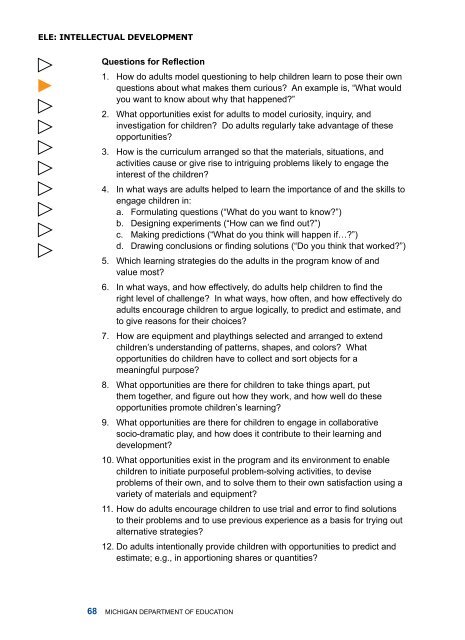Early Childhood Standards of Quality for ... - State of Michigan
Early Childhood Standards of Quality for ... - State of Michigan
Early Childhood Standards of Quality for ... - State of Michigan
Create successful ePaper yourself
Turn your PDF publications into a flip-book with our unique Google optimized e-Paper software.
ELE: Intellectual DevelopmentQuestions <strong>for</strong> Reflection1. How do adults model questioning to help children learn to pose their ownquestions about what makes them curious? An example is, “What wouldyou want to know about why that happened?”2. What opportunities exist <strong>for</strong> adults to model curiosity, inquiry, andinvestigation <strong>for</strong> children? Do adults regularly take advantage <strong>of</strong> theseopportunities?3. How is the curriculum arranged so that the materials, situations, andactivities cause or give rise to intriguing problems likely to engage theinterest <strong>of</strong> the children?4. In what ways are adults helped to learn the importance <strong>of</strong> and the skills toengage children in:a. Formulating questions (“What do you want to know?”)b. Designing experiments (“How can we find out?”)c. Making predictions (“What do you think will happen if…?”)d. Drawing conclusions or finding solutions (“Do you think that worked?”)5. Which learning strategies do the adults in the program know <strong>of</strong> andvalue most?6. In what ways, and how effectively, do adults help children to find theright level <strong>of</strong> challenge? In what ways, how <strong>of</strong>ten, and how effectively doadults encourage children to argue logically, to predict and estimate, andto give reasons <strong>for</strong> their choices?7. How are equipment and playthings selected and arranged to extendchildren’s understanding <strong>of</strong> patterns, shapes, and colors? Whatopportunities do children have to collect and sort objects <strong>for</strong> ameaningful purpose?8. What opportunities are there <strong>for</strong> children to take things apart, putthem together, and figure out how they work, and how well do theseopportunities promote children’s learning?9. What opportunities are there <strong>for</strong> children to engage in collaborativesocio-dramatic play, and how does it contribute to their learning anddevelopment?10. What opportunities exist in the program and its environment to enablechildren to initiate purposeful problem-solving activities, to deviseproblems <strong>of</strong> their own, and to solve them to their own satisfaction using avariety <strong>of</strong> materials and equipment?11. How do adults encourage children to use trial and error to find solutionsto their problems and to use previous experience as a basis <strong>for</strong> trying outalternative strategies?12. Do adults intentionally provide children with opportunities to predict andestimate; e.g., in apportioning shares or quantities?68 <strong>Michigan</strong> Department <strong>of</strong> Education


